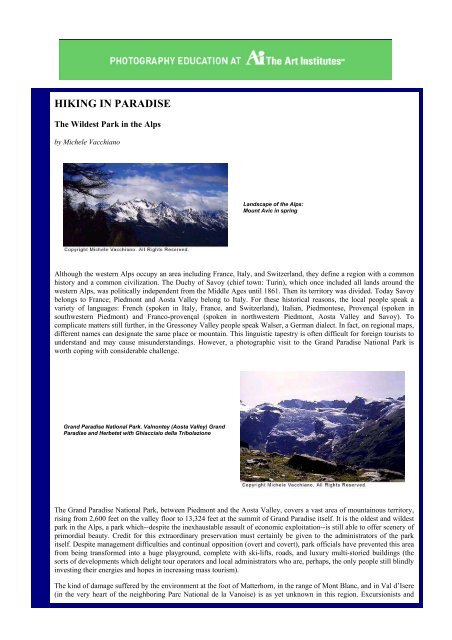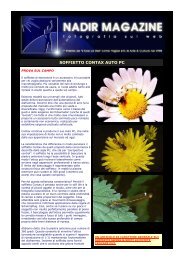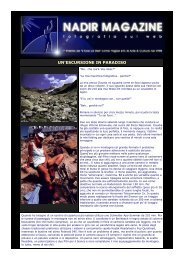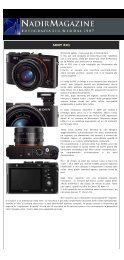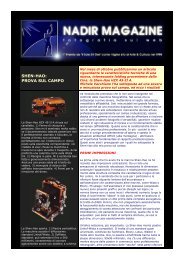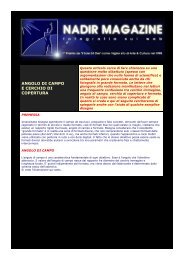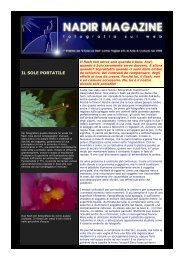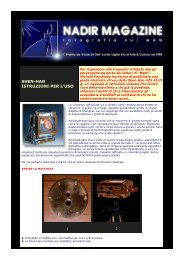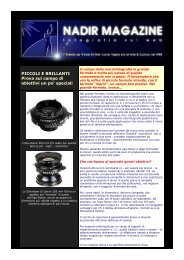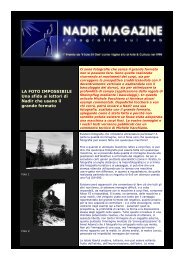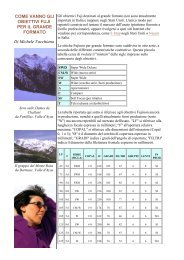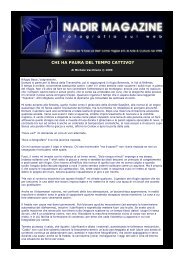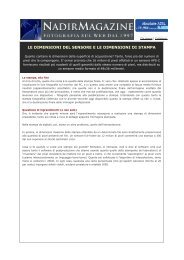The Grand Paradise National Park - Michele Vacchiano
The Grand Paradise National Park - Michele Vacchiano
The Grand Paradise National Park - Michele Vacchiano
You also want an ePaper? Increase the reach of your titles
YUMPU automatically turns print PDFs into web optimized ePapers that Google loves.
HIKING IN PARADISE<br />
<strong>The</strong> Wildest <strong>Park</strong> in the Alps<br />
by <strong>Michele</strong> <strong>Vacchiano</strong><br />
Landscape of the Alps:<br />
Mount Avic in spring<br />
Although the western Alps occupy an area including France, Italy, and Switzerland, they define a region with a common<br />
history and a common civilization. <strong>The</strong> Duchy of Savoy (chief town: Turin), which once included all lands around the<br />
western Alps, was politically independent from the Middle Ages until 1861. <strong>The</strong>n its territory was divided. Today Savoy<br />
belongs to France; Piedmont and Aosta Valley belong to Italy. For these historical reasons, the local people speak a<br />
variety of languages: French (spoken in Italy, France, and Switzerland), Italian, Piedmontese, Provençal (spoken in<br />
southwestern Piedmont) and Franco-provençal (spoken in northwestern Piedmont, Aosta Valley and Savoy). To<br />
complicate matters still further, in the Gressoney Valley people speak Walser, a German dialect. In fact, on regional maps,<br />
different names can designate the same place or mountain. This linguistic tapestry is often difficult for foreign tourists to<br />
understand and may cause misunderstandings. However, a photographic visit to the <strong>Grand</strong> <strong>Paradise</strong> <strong>National</strong> <strong>Park</strong> is<br />
worth coping with considerable challenge.<br />
<strong>Grand</strong> <strong>Paradise</strong> <strong>National</strong> <strong>Park</strong>. Valnontey (Aosta Valley) <strong>Grand</strong><br />
<strong>Paradise</strong> and Herbetet with Ghiacciaio della Tribolazione<br />
<strong>The</strong> <strong>Grand</strong> <strong>Paradise</strong> <strong>National</strong> <strong>Park</strong>, between Piedmont and the Aosta Valley, covers a vast area of mountainous territory,<br />
rising from 2,600 feet on the valley floor to 13,324 feet at the summit of <strong>Grand</strong> <strong>Paradise</strong> itself. It is the oldest and wildest<br />
park in the Alps, a park which--despite the inexhaustable assault of economic exploitation--is still able to offer scenery of<br />
primordial beauty. Credit for this extraordinary preservation must certainly be given to the administrators of the park<br />
itself. Despite management difficulties and continual opposition (overt and covert), park officials have prevented this area<br />
from being transformed into a huge playground, complete with ski-lifts, roads, and luxury multi-storied buildings (the<br />
sorts of developments which delight tour operators and local administrators who are, perhaps, the only people still blindly<br />
investing their energies and hopes in increasing mass tourism).<br />
<strong>The</strong> kind of damage suffered by the environment at the foot of Matterhorn, in the range of Mont Blanc, and in Val d’Isere<br />
(in the very heart of the neighboring Parc <strong>National</strong> de la Vanoise) is as yet unknown in this region. Excursionists and
skiers hungry for real contact with nature, instead of another chance to practice their athletic performance, can find it here.<br />
Of course, we could debate at length about the timeliness of creating uncontaminated oases in a world that is galloping<br />
toward ecological catastrophy. Some could argue that the existence of parks and natural reserves actually legitimizes the<br />
destruction of the environment outside them. But until respect for nature becomes a part of our way of viewing the world<br />
(until now dominated by a logic of depredation), parks alone are left to care for the remaining wilderness. Thus, scholars<br />
and lovers of nature can observe and appreciate what we are relentlessly destroying on the rest of this planet.<br />
Even if a national park can protect the environment and preserve it intact for future generations, it can do nothing to<br />
prevent the gradual yet unrelenting destruction of the local civilization. This degeneration has tangled roots. It's a sort of<br />
cultural colonization which is difficult to identify and impossible to stop. As each old man dies, the languages, beliefs,<br />
and traditions of the mountains are disappearing forever. <strong>The</strong> clumsy, superficial attempts made by folk groups cannot<br />
bring them back to life. A culture is not a collection of dances, songs, and proverbs, but a way of understanding the world,<br />
an extremely complex semiological code that cannot be reproduced by anyone who isn't a living part of it.<br />
Perhaps this extinction, too, is an ineluctable phenomenon, part of world evolution. Like many greater and better known<br />
past civilizations, the mountain communities and their culture are going to die out. <strong>The</strong>ir deaths will come without too<br />
much ado, in silence, with discretion, as is the custom here.<br />
A priority goal of current park policy is the education of people toward a new way of relating to the environment.<br />
Teaching programs in schools and summer activities for children and adults (such as workshops about nature<br />
photography) are helping both foreign and native tourists alike to understand the complicated interactions underlying the<br />
territory even before their first approach to the park. A photographer looking for impressive images can find them easily<br />
here. <strong>The</strong> beauty and magnificence of these valleys and mountains, their evocation of a still uncontamined nature, plus the<br />
emotions stirred by their wildlife will remain in his soul (and on his film) as an indelible memory.<br />
<strong>Grand</strong> <strong>Paradise</strong> <strong>National</strong> <strong>Park</strong>. Valnontey (Aosta Valley).<br />
Rocciaviva and Glacier du Money from east ridge of Herbetet<br />
<strong>The</strong> mountains of <strong>Grand</strong> <strong>Paradise</strong> group were sculpted by glaciers during the Quaternary glaciations, which created the<br />
valleys we see today. Above the larch forests, you can find high alpine meadows bright with flowers in summer (when<br />
you can spot very rare species of flowers) and dominated by the highest peaks of the massif. Here you can walk above the<br />
clouds among myriad glacial lakes, cross a mountain pass while surrounded by steinbocks, and--if you sit down to admire<br />
the landscape--marmots may come to inspect you. In front of you, the glaring splendor of glaciers or the austere majesty<br />
of towering peaks spread out in an almost overwhelming panorama.<br />
Obviously, you'll need serious photographic equipment. Here are my suggestions:<br />
Wide-angle lenses for the human environment. I suggest a simple 28 mm (45-55 in medium format) for the little<br />
villages with their dry-walled houses or the "baite" (alpine huts) for summer pasture. In large format, I use a 90 mm<br />
Super-Angulon.<br />
A normal lens for scenery. (Do not use wide-angle lenses, or the mountains will appear exaggeratedly small and<br />
faraway.)<br />
A telephoto lens for animals. In the park, you can get close to steinbocks (Capra ibex ibex) quite easily. <strong>The</strong>y are<br />
accustomed to human presence, so--as long as you move slowly and quietly--you don’t need extreme focal lengths. From<br />
200 to 300 mm in small format, from 300 to 500 in medium format will allow you to capture excellent photos.
Orco Valley (Piedmont).<br />
Male steinbock<br />
Some of the animals you may encounter include the following:<br />
Chamois (Rupicapra rupicapra) are fearful and suspicious. If you're lucky, you might be able to approach a lonely young<br />
male, but when you reach a distance of about 60 feet from your subject, it will run away headlong. So you need a very<br />
long telephoto lens--500 mm or more.<br />
<strong>The</strong> marmot (Marmota marmota) is a curious and lively fur-ball that runs, plays, and gobbles close to the burrows when it<br />
isn't hibernating during the winter. At the first sign of danger, a marmot sentry blows its piercing whistle and all the furry<br />
creatures disappear into their holes. To photograph marmots, you have to lie down, wait, and hide. You can also place<br />
your camera in front of a hole, go away, and watch through binoculars. When the marmot emerges from his burrow, you<br />
can take your photo by remote control. Marmots also like searching in dustbins. If you leave your rucksack on the<br />
ground, a marmot may come to check if you've brought him something to eat.<br />
<strong>The</strong> eagle (Aquila chrysaëtus) is not rare in the park. <strong>The</strong>re are a few pairs that build their nests on inaccessible rocks.<br />
You can spot eagles circling the valleys, but it's very difficult (and strictly forbidden) for anyone to approach the nests.<br />
<strong>The</strong> bearded vulture (Gypaetus barbatus) feeds mainly on the bones of carrion. It disappeared from the western Alps in<br />
1912. However, a few years ago, an international project reintroduced Gypaetus in the neighboring Parc <strong>National</strong> de la<br />
Vanoise. It's no longer hard to see one of these magnificent birds.<br />
<strong>The</strong> Tengmalm’s owl (Aegolius funereus) lives in coniferous forests. You can often hear the "hoo-hoo" of this nocturnal<br />
bird of prey. To photograph nocturnal birds, you have to lie down, waiting close to the nest, and watch attentively in the<br />
dark. Infrared equipment will help you. Autofocus lenses are recommended, if they can work together with an<br />
infrared-operating flash.<br />
<strong>The</strong> effects of flash photography on nocturnal birds is a matter of debate among nature photographers. Some say no harm<br />
is done, but I'm not so sure. Bird retinas can tolerate the sunlight. Even owls and other nocturnal birds can look at the sun<br />
without damage, compared with mammals that are less fortunate. Sunlight is certainly brighter than that produced by an<br />
electronic flash. However, a retina requires about thirty minutes to adapt to the dark after being exposed to a sudden light.<br />
This fact could be crucial for the survival of nocturnal birds.<br />
<strong>The</strong> crossbill (Loxia fulvirostrata) uses its cross-over beak to snatch seeds out of pine cones. <strong>The</strong> male can be recognized<br />
by its red-orange feathering.<br />
<strong>The</strong> <strong>Grand</strong> <strong>Paradise</strong> woods and meadows shelter the homes of many birds. To photograph them, you'll need a long focal<br />
length--600 mm or more. You can obtain superior results by hiding under a camouflage sheet. Do not use tents. Camping<br />
outside authorized areas is forbidden.<br />
A macro lens for flowers and insects. <strong>The</strong> focal length of your macro lens should be higher than normal. 100 or 200<br />
mm allows you to work without frightening your subject. You'll also need a pair of little flashes to compensate for the<br />
light decrease due to the magnification.<br />
Flowers and insects are good subjects in the summer. Butterfly Parnassius<br />
apollo is one of the emblems of the park. At high altitude, above the tree line,<br />
the summer rejoices as thousands of little flowers, as well as gaily colored<br />
butterflies and grasshoppers intoxicated with love, flood the meadows with a<br />
symphony of life. You have to look carefully in the grass to spot the myriad
forms of life we so often unwittingly crush underfoot. You can photograph<br />
insects very easily when they're either feeding or mating. However, if you like<br />
photographing insects, you must be ready to be stung, bitten, or sprinkled by<br />
irritating fluids whenever you cross the animal’s safety limit. But it’s not<br />
important.<br />
Nature photography is an absorbing activity you cannot give up, because when<br />
you're hiking in the mountains, perhaps standing on a glacier to photograph the<br />
thousand faces of nature, to inhale the thousand smells of life, then you feel alive! <strong>The</strong>n you can create a message of love.<br />
You can openly reveal your respect for all forms of life. And if someone understands your message and shares it, then<br />
your work will be successful. It will be a sign you will leave in the world--a little footprint that will remain on the path<br />
when your journey comes to an end.<br />
SOME INFORMATION ABOUT THE PARK<br />
Head offices: Parco Nazionale Gran Paradiso - Via della Rocca 47 - 10123 Turin (Italy) (Phone: +39 11 8171187)<br />
"Paradisia" Alpine Botanical Garden - Valnontey-Cogne AO (Italy) (Phone: +39 165 74147)<br />
Visitors Centers:<br />
Ronco Canavese (Soana Valley, Piedmont). <strong>The</strong> center is in the Old Town Hall. <strong>The</strong>re is a permanent exhibition on the<br />
chamois.<br />
Noasca (Orco Valley, Piedmont). In the Town Hall, this is the <strong>Park</strong> Tourist Secretariat, and houses a permanent<br />
exhibition on geology, a teaching laboratory and a projection room.<br />
Ceresole Reale (Orco Valley, Piedmont). This center houses a permanent exhibition on the steinbock.<br />
Rhêmes Notre Dame (Aosta Valley). Permanent exhibition on the bearded vulture.<br />
Dégioz Valsavarenche (Aosta Valley). Permanent exhibition on the lynx and other predators.<br />
About <strong>Michele</strong> <strong>Vacchiano</strong><br />
<strong>Michele</strong> <strong>Vacchiano</strong> was born in Turin (Piedmont, northwestern Italy) in 1951. He holds a Master of Arts degree earned from the<br />
University of Turin in 1979. He has written several books about nature photography for important Italian publishers. He usually works in<br />
the western Alps, and especially in the <strong>Grand</strong> <strong>Paradise</strong> <strong>National</strong> <strong>Park</strong>, about which he wrote the photographic book La roccia incantata<br />
(<strong>The</strong> Enchanted Rock). He also made some documentary audiovisuals about mountain life.<br />
From 1986 to 1995 he taught Techniques and Aesthetics of Photography at the Journalism School and at the Superior Institute for<br />
Communication Sciences of Turin. He wrote an essay entitled L’ordine apparente (<strong>The</strong> Seeming Order) about the semiology of visual<br />
communications. He was promoter and president of the Association for Nature, Photography and Alpine Culture Research (ARNICA). He<br />
is a member of the World Field Photographers Association. He contributes to several newspapers and photography agencies. His pictures<br />
were exhibited on several occasions and have achieved a considerable success.<br />
<strong>Michele</strong> <strong>Vacchiano</strong> presently lives with his son near the center of Turin, but as often as possible, he leaves town for a lonely sixteenth<br />
century house at the foot of Monte Rosa. At the moment, he is writing some new books.<br />
Contact email: mv@michelevacchiano.com<br />
Home Page: www.michelevacchiano.com<br />
See more of <strong>Vacchiano</strong>'s images on Apogee Photo Magazine by clicking here.<br />
BACK to the previous page.<br />
Back to the home page<br />
Apogee Photo and Apogee Photo Magazine are trademarks of Apogee Photo, Inc. Copyright © 1995-2000. Apogee Photo, Inc. All Rights Reserved.


